Top Chat Marketing Trends Shaping 2025

Chat marketing is revolutionizing how businesses connect with customers in 2025. You can see its transformative power in the numbers: live chat usage has surged by 400% since 2015, and the market for live chat software continues to grow at nearly 9% annually. This trend reflects how much customers value instant communication, with 73% finding live chat the most satisfying way to interact with brands. Businesses that embrace these tools often enjoy up to a 48% boost in revenue per chat hour and see 38% of customers make purchases after positive interactions.
Adapting to these trends isn’t optional. Nearly 80% of businesses already use AI chatbots to improve customer engagement and marketing strategies. Companies that invest in these technologies report higher-quality leads and greater efficiency. With platforms like Sobot offering cutting-edge solutions, you can stay ahead of competitors while delivering seamless and personalized experiences. Chat marketing will shape the future of customer interactions, and now is the time to harness its potential.
Smarter Conversational AI Redefines Chat Marketing

Advances in AI and natural language processing (NLP)
Conversational AI has reached new heights in 2025, transforming how businesses engage with customers. Recent breakthroughs in natural language processing (NLP) have enabled chatbots to understand nuanced language, recognize intent more accurately, and generate human-like responses. These advancements allow for richer, multimodal interactions, such as combining text, voice, and images for seamless communication. Hyper-personalization has also emerged as a key trend, enabling tailored marketing strategies that resonate with individual customers.
For example, companies like Hello Fresh and Emirates Airlines have successfully implemented conversational AI to enhance customer engagement. Hello Fresh’s chatbot, Freddy, reduced response times by 76% while increasing incoming messages by 47%. Similarly, Emirates Airlines combined conversational AI with display ads, achieving an 87% boost in consumer engagement. These examples highlight how AI marketing trends are reshaping customer interactions across industries.
How Sobot's Chatbot enhances customer interactions
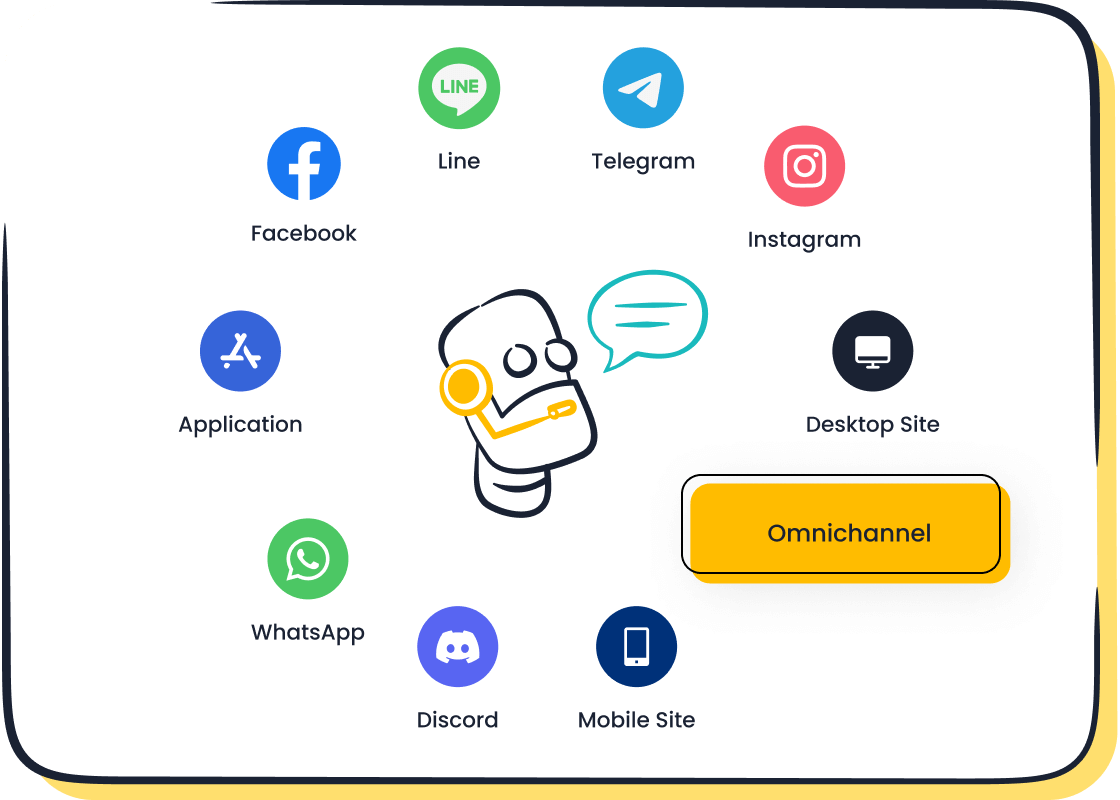
Sobot’s AI-powered chatbot exemplifies the potential of conversational AI. It operates 24/7, handling routine queries autonomously and assisting agents with complex issues. This approach reduces inbound discussions by 20% and ensures a 97% customer satisfaction rate. The chatbot’s multilingual capabilities and omnichannel support make it a versatile tool for businesses aiming to improve engagement across platforms like WhatsApp, SMS, and social media.
The chatbot also excels in delivering accurate responses, with an 80% correct answer rate. Its proactive messaging and real-time intent assistance boost conversions by 20%, while its no-coding-required setup ensures accessibility for businesses of all sizes. With Sobot, you can streamline operations, cut costs, and enhance customer happiness.
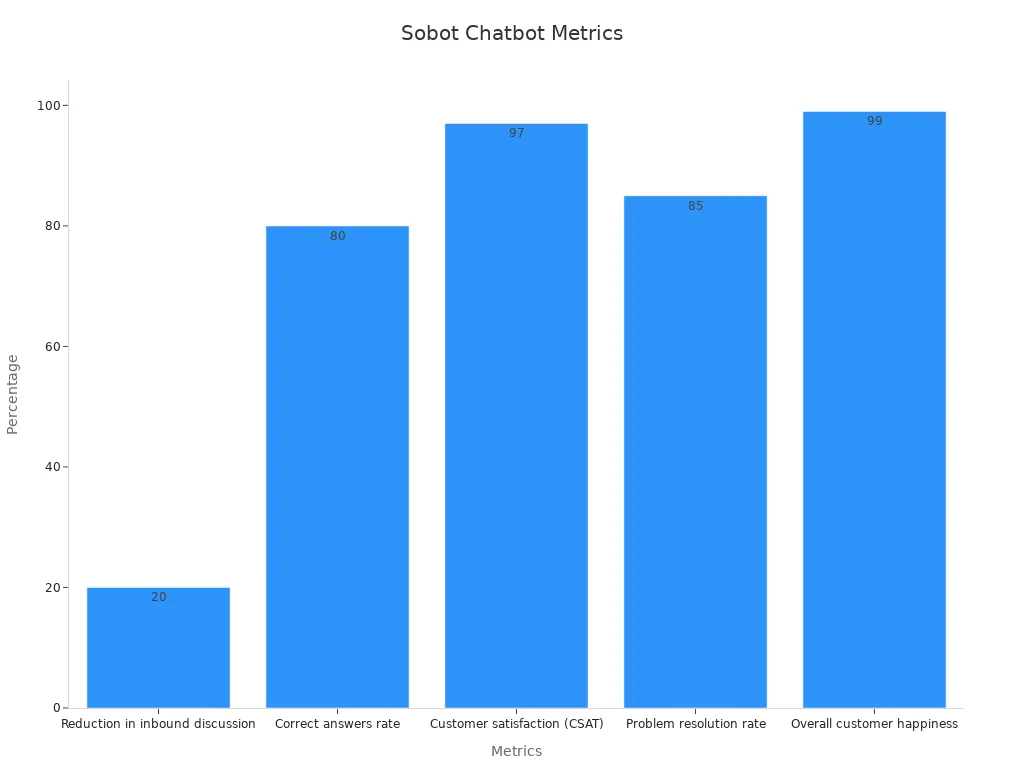
Actionable tips for integrating smarter AI into your strategy
To leverage smarter AI in your marketing strategy, start by identifying repetitive tasks that can be automated. Use AI to analyze customer data and deliver personalized experiences. For instance, Nordstrom uses AI for inventory management, improving sales and customer satisfaction. Similarly, Rockwell Automation employs predictive AI tools to reduce downtime and save costs.
When implementing AI, focus on omnichannel integration to ensure consistent customer experiences. Platforms like Sobot simplify this process by offering AI solutions tailored to your business needs. Regularly monitor performance metrics, such as customer satisfaction and resolution rates, to optimize your AI tools. By adopting these strategies, you can stay ahead of marketing trends and deliver exceptional customer experiences.
Omnichannel Chat Marketing for Seamless Customer Journeys
The importance of unified customer experiences
In 2025, customers expect seamless interactions across all touchpoints. A unified experience ensures that no matter where or how they engage with your brand, the journey feels consistent and connected. Research shows that 79% of customers expect this level of integration, yet only 55% feel they receive it. Similarly, 90% of consumers desire smooth transitions between channels, but only 29% of businesses deliver on this expectation. This gap presents a significant opportunity for brands to stand out.
Unified customer experiences also drive measurable results. Companies with effective omnichannel strategies retain 89% of their customers, compared to just 33% for those without. Additionally, businesses that prioritize the customer journey see faster sales cycles, increased cross-sell revenue, and improved customer service costs. The benefits are clear: a cohesive approach not only enhances satisfaction but also boosts your bottom line.
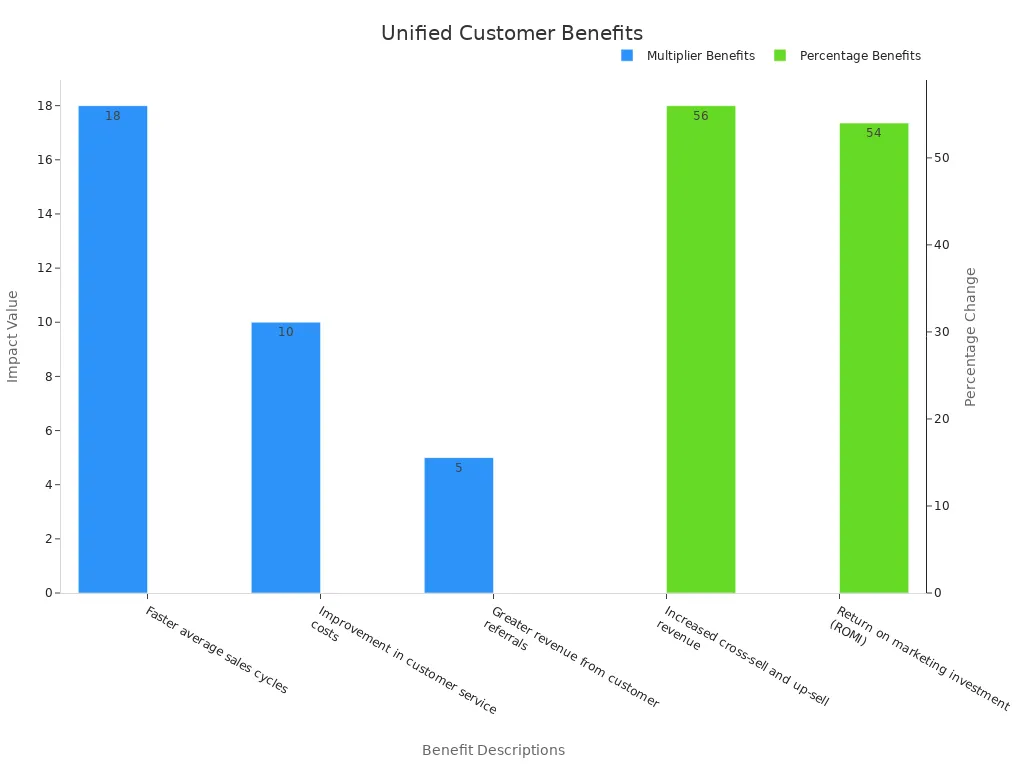
Sobot's omnichannel solutions for retail and e-commerce
Sobot’s omnichannel solutions empower businesses to deliver seamless customer journeys. By integrating chat, email, voice, and social media into a single platform, Sobot ensures that every interaction feels connected. For example, retail and e-commerce brands can use Sobot to unify customer profiles, enabling personalized recommendations and consistent support across channels.
The results speak for themselves. Brands using Sobot’s solutions have seen up to a 30% boost in retention and a 20% increase in conversion rates. Engaged customers are also 67% more likely to recommend your brand, further amplifying your marketing efforts. With Sobot, you can streamline operations, enhance engagement, and build lasting customer loyalty.
Steps to implement an effective omnichannel strategy
To create a successful omnichannel strategy, follow these steps:
- Map the customer journey: Identify key touchpoints and ensure they align with your brand’s messaging. Only 36% of companies currently do this, so it’s a chance to gain a competitive edge.
- Integrate your platforms: Use tools like Sobot to unify communication channels, ensuring consistent experiences across chat, email, and social media.
- Leverage AI-powered content creation: Automate workflows and personalize interactions using AI insights. This approach reduces costs and improves efficiency.
- Monitor and optimize: Regularly analyze performance metrics like customer satisfaction and resolution rates to refine your strategy.
Brands like Nike and Sephora have successfully implemented these steps, using mobile apps, personalized campaigns, and unified profiles to enhance customer experiences. By adopting a similar approach, you can stay ahead of marketing trends and deliver exceptional results.
Hyper-Personalization with AI Marketing Trends
Leveraging data for tailored customer interactions
Hyper-personalization is transforming marketing in 2025 by enabling businesses to deliver experiences that resonate deeply with individual customers. By leveraging customer data, you can craft timely and relevant messaging that enhances engagement and builds loyalty. For instance, a Customer Data Platform (CDP) consolidates information like preferences and behaviors, giving you a holistic view of your audience. This insight allows you to create conversational marketing strategies that feel personal and meaningful.
Personalization doesn’t just improve customer satisfaction—it drives measurable results. Research shows that AI-powered personalization increases average order value by 40% and boosts engagement rates by 83%. These statistics highlight the importance of integrating data-driven strategies into your chat marketing efforts. When you use tools like predictive analytics, you can anticipate customer needs and deliver solutions proactively, creating a seamless and satisfying experience.
Sobot's AI-driven insights for personalized marketing
Sobot’s AI solutions empower businesses to unlock the full potential of hyper-personalization. By analyzing customer data, Sobot provides actionable insights that improve response rates by up to 35% and accuracy by 15%. Its AI-powered content creation tools streamline workflows, reducing knowledge base maintenance by 80%. These capabilities allow you to focus on delivering personalized marketing campaigns that drive conversions and build lasting relationships.
For example, Sobot’s chatbot uses real-time analytics to understand customer intent and provide tailored recommendations. This approach not only enhances engagement but also boosts customer satisfaction. With Sobot, you can integrate omnichannel support and AI-driven insights to create marketing strategies that align with the latest trends in 2025.
| Metric | Improvement Range |
|---|---|
| Response Rate | 15% - 35% |
| Accuracy | 5% - 15% |
| Knowledge Base Maintenance | 80% reduction |
Best practices for ethical data usage in chat marketing
Ethical data usage is essential for building trust and ensuring compliance in chat marketing. To use customer data responsibly, follow these best practices:
- Consent: Always obtain explicit consent from users before collecting their data. Timing matters—ask for consent when users are most likely to engage positively.
- Data Minimization: Collect only the data necessary to achieve specific marketing goals. This reduces the risk of breaches and protects user privacy.
- Transparency: Be clear about how you use customer data. Transparency fosters trust and encourages users to share their information willingly.
By adhering to these principles, you can leverage data effectively while maintaining ethical standards. Sobot’s AI solutions prioritize data security and compliance, helping you implement these practices seamlessly. With tools like encrypted backups and GDPR compliance, Sobot ensures that your marketing strategies align with industry guidelines.
Voice-Enabled Chat as a Game-Changer
The rise of voice assistants in customer engagement
Voice-enabled chat is transforming customer engagement in 2025. More than half of global searches are now voice-driven, reflecting a growing preference for hands-free interactions. Industries like healthcare, banking, and e-commerce are investing heavily in voice bots to meet this demand. Consumers increasingly favor platforms that combine voice and text-based interfaces, creating seamless experiences.
Voice assistants also enhance satisfaction. Studies show that 93% of users are satisfied with their voice assistants, with 50% reporting they are very satisfied. This trust drives frequent usage, enabling purchases and inquiries with simple voice commands. For example, conversational banking uses voice technology to simplify transactions, making it a significant trend in customer engagement.
| Statistic/Trend | Description |
|---|---|
| Voice-driven searches | More than 50% of all searches will be voice-driven according to Forbes. |
| Conversational banking | Voice is becoming a significant trend in banking, enhancing user experience. |
Use cases for voice-enabled chat in e-commerce
Voice-enabled chat is revolutionizing e-commerce by offering hands-free convenience. Customers can search for products, check order statuses, and even complete purchases using voice commands. This technology reduces friction in the buying process, increasing conversion rates. For example, voice assistants help customers find items faster, reducing cart abandonment.
Retailers also use voice bots for personalized recommendations. By analyzing customer preferences, these bots suggest products tailored to individual needs. This approach boosts average order values and enhances satisfaction. Sobot’s AI solutions integrate voice capabilities, enabling businesses to deliver these experiences seamlessly.
| Metric | Value |
|---|---|
| Satisfaction Rate | 93% of consumers are satisfied with their voice assistants. |
| Very Satisfied | 50% of consumers report being very satisfied. |
How to integrate voice technology with Sobot's solutions
Sobot makes integrating voice technology simple and effective. Its AI platform supports real-time speech recognition and reasoning, enabling natural conversations. Businesses can use Sobot’s omnichannel solutions to unify voice, chat, and email interactions, ensuring consistent customer experiences.
To implement voice-enabled chat, start by identifying key customer touchpoints. Use Sobot’s AI copilots to assist agents with voice interactions, improving response times. Configure voice bots to handle routine inquiries, freeing up agents for complex tasks. Regularly monitor performance metrics like resolution rates to optimize your strategy.
Sobot’s voice capabilities also support outbound marketing. Automated voice campaigns can boost sales by over 30%, helping you stay ahead of chat marketing trends in 2025. With Sobot, you can deliver hands-free convenience and personalized experiences that resonate with your audience.
Predictive Analytics for Proactive Customer Engagement
Transforming chat marketing with predictive analytics
Predictive analytics is revolutionizing chat marketing by enabling businesses to anticipate customer needs and act proactively. This approach uses data to identify patterns in customer behavior, helping you address issues before they arise. For example, predictive systems can forecast ticket surges during sales events or pinpoint customers at risk of leaving. By analyzing customer language with natural language processing (NLP), these tools also gauge tone and emotion, offering deeper insights into customer sentiment.
| Evidence | Description |
|---|---|
| Predictive capabilities | Systems can predict potential issues, such as increased ticket volumes. |
| NLP tools | Analyze customer language to gauge tone and emotion. |
| Behavior analysis | Triggers assistance based on customer actions, enhancing their experience. |
Predictive analytics aligns your marketing and customer service efforts with data-driven insights. This ensures you focus on solutions that truly resonate with your audience. By adopting this trend, you can improve engagement and build stronger customer relationships.
Examples of proactive engagement strategies
Proactive engagement strategies powered by predictive analytics can transform how you interact with customers. For instance, identifying high-intent customers allows you to offer personalized recommendations at the right moment. Timing is crucial—engaging customers when they are most likely to act increases conversions and satisfaction.
| Step | Description |
|---|---|
| 1 | Identify customer journeys that benefit from proactive chat. |
| 2 | Focus on customers with the highest intent to purchase. |
| 3 | Determine the optimal timing for engagement. |
| 4 | Decide on the type of offer to present to the customer. |
| 5 | Ensure the presentation of the offer is effective. |
| 6 | Invest in the training and quality of chat agents. |
For example, platforms like Salesforce Einstein use predictive analytics to boost lead conversions by 50%. Similarly, Google Ads leverages user behavior data to improve ad targeting, resulting in a 15% increase in conversions. These strategies highlight how predictive analytics can elevate your marketing performance.
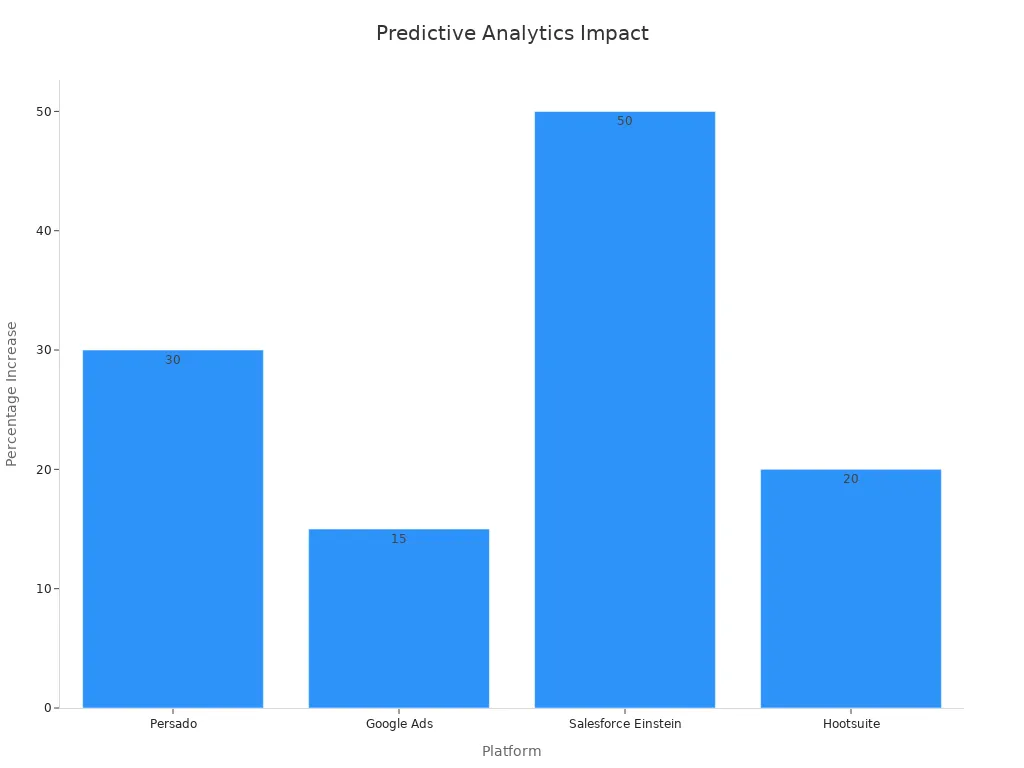
Tools like Sobot's AI insights for predictive analytics
Sobot’s AI insights empower you to harness predictive analytics effectively. The platform reduces average wait times by 20% through AI-driven call routing and improves first-call resolution rates by 10%. Its AI-powered chatbots cut average handle times by up to 20%, allowing your team to focus on more complex tasks. These tools also enhance agent performance, boosting customer satisfaction scores by 20%.
| Statistic Description | Improvement Percentage |
|---|---|
| Average wait times reduced by AI-driven call routing | 20% |
| First Call Resolution (FCR) rates improved | 10% |
| Average handle times reduced by AI-powered chatbots | 15-20% |
| Post-call work reduced by AI systems | 25% |
| Agent Customer Satisfaction (CSAT) scores improved | 20% |
By integrating Sobot’s AI-driven audience segmentation and analytics tools, you can align your marketing strategies with customer needs. This approach ensures personalized marketing campaigns that resonate with your audience, driving engagement and loyalty.
Chatbots Revolutionizing E-Commerce Experiences
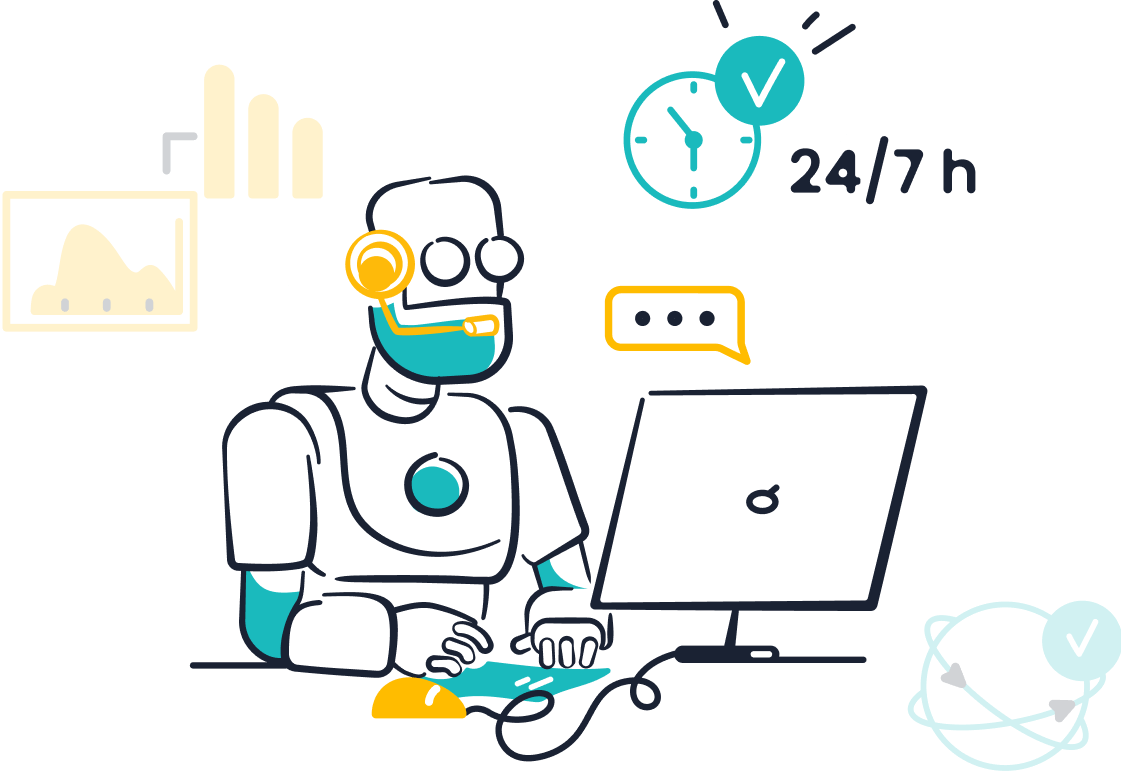
The role of Sobot's Chatbot in streamlining online shopping
Chatbots are transforming e-commerce by simplifying the shopping experience for customers. Sobot’s AI-powered chatbot plays a pivotal role in this trend. It operates around the clock, handling routine inquiries and assisting customers with product recommendations. This proactive approach reduces cart abandonment and improves satisfaction. For example, Sobot’s chatbot achieves an impressive 83% resolution rate, ensuring customers receive timely and accurate responses.
The chatbot also boosts repurchase rates by 57%, demonstrating its ability to foster customer loyalty. Its multilingual capabilities and omnichannel support allow businesses to engage customers across platforms like WhatsApp and SMS. By integrating Sobot’s chatbot, you can streamline operations, enhance customer experiences, and drive higher sales.
Tip: Use Sobot’s chatbot to automate repetitive tasks and focus on delivering personalized shopping experiences.
Benefits of chatbot integration for e-commerce businesses
Integrating chatbots into your e-commerce strategy offers numerous benefits. Chatbots improve conversion rates by guiding customers through the buying process and reducing friction. For instance, Domino’s Pizza saw a 50% increase in digital orders after implementing a chatbot, while Marriott International achieved a 44% boost in direct bookings.
Chatbots also enhance productivity by automating routine tasks, allowing human agents to focus on complex inquiries. Businesses report a 61% increase in productivity and a 55% rise in high-quality leads due to chatbot integration. Additionally, chatbots resolve 90% of complaints faster, improving customer satisfaction.
| Statistic Description | Percentage/Value |
|---|---|
| Increase in sales due to chatbots | 67% |
| Sales transactions initiated from bot interaction | 26% |
| Returns and cancellations resolved by digital assistants | 58% |
| Faster complaint resolution due to bots | 90% |
| Conversion rates achieved by chatbots in specific industries | 70% |
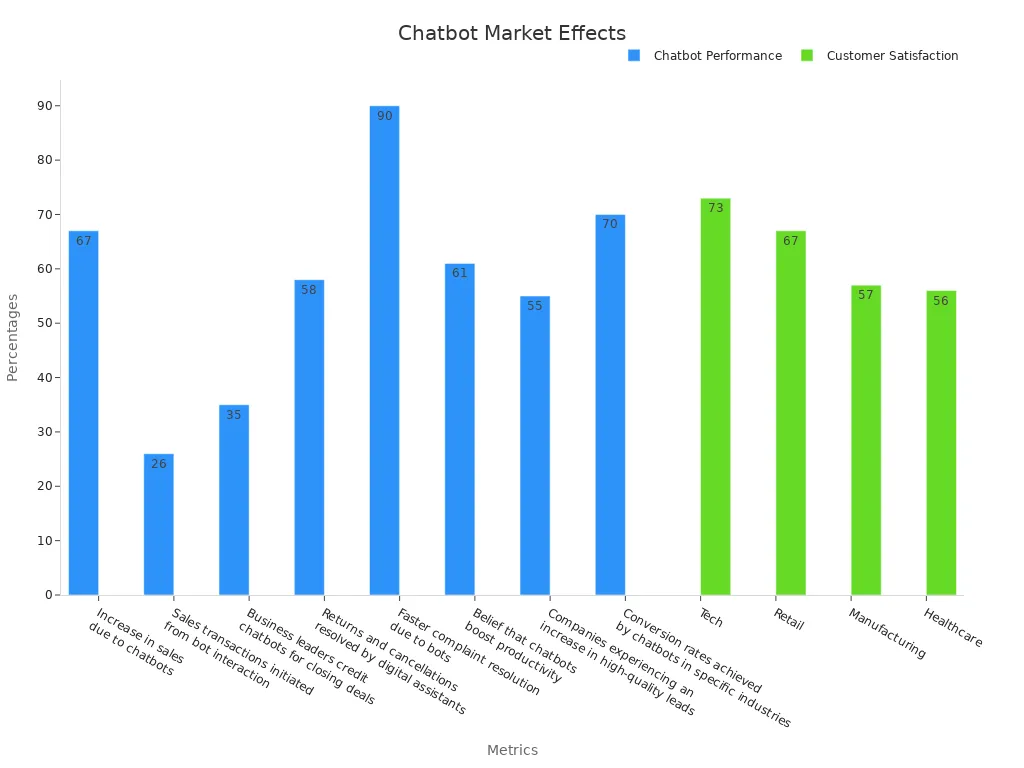
Tips for optimizing chatbot performance in e-commerce
To maximize the impact of chatbots in e-commerce, focus on optimization. Start by monitoring key metrics like retention rates, user visits, and purchases achieved. Regular updates with new branding and messaging keep interactions fresh and relevant. Training chatbots on topics with insufficient responses enhances user experience.
Automating routine tasks allows human agents to handle complex inquiries, improving overall efficiency. Limit conversational steps to ten to reduce user frustration. Continuous monitoring of user needs ensures high performance and satisfaction.
| Metric | Description |
|---|---|
| Number of active users | Indicates how many users are currently engaging with the chatbot. |
| Retention rate | Measures the percentage of users who return to use the chatbot again. |
| Purchases achieved | Counts the successful transactions completed through the chatbot. |
| Recovered abandoned carts | Shows how many abandoned carts were successfully converted into purchases. |
Note: Sobot’s chatbot simplifies optimization with its user-friendly interface and actionable insights, helping you deliver exceptional e-commerce experiences.
The chat marketing trends shaping 2025 highlight the transformative potential of smarter AI, omnichannel strategies, hyper-personalization, voice-enabled chat, predictive analytics, and advanced chatbots. These innovations redefine customer engagement, offering businesses opportunities to enhance satisfaction, boost efficiency, and drive growth.
Tools like Sobot's Chatbot exemplify this evolution. By automating workflows and delivering personalized experiences, businesses across industries have achieved remarkable results.
“Our productivity soared after integrating automated workflows,” said Sarah Johnson, Operations Manager at ShopSmart. “It’s been a game-changer for our team.”
| Industry | Company | Automation Impact | Productivity Gain |
|---|---|---|---|
| E-commerce | ShopSmart | 40% reduction in response times | 25% increase in order processing |
| Healthcare | MedCare | 35% improvement in resolution rates | 30% reduction in support queries |
| Financial Services | BankEase | 50% faster issue resolution | 20% boost in customer satisfaction |
Adapting to these trends ensures your business stays competitive. Embrace innovation, leverage tools like Sobot, and transform your marketing strategy to meet the demands of 2025.
FAQ
What is chat marketing, and why is it important in 2025?
Chat marketing uses AI-powered tools like chatbots to engage customers through messaging platforms. It’s important because it improves customer satisfaction, boosts conversions, and reduces operational costs. In 2025, businesses that adopt chat marketing gain a competitive edge by delivering instant, personalized interactions.
How does Sobot ensure data security in chat marketing?
Sobot prioritizes data security with features like GDPR compliance, encrypted backups, and real-time monitoring. These measures protect customer information and ensure your business complies with global data privacy regulations. You can confidently use Sobot’s tools without worrying about data breaches.
Can small businesses benefit from Sobot’s solutions?
Yes! Sobot’s no-coding-required setup and scalable tools make it ideal for small businesses. You can automate repetitive tasks, reduce costs, and improve customer engagement without needing a large team or technical expertise. Sobot’s solutions grow with your business.
How do I measure the success of my chat marketing strategy?
Track metrics like customer satisfaction (CSAT), resolution rates, and conversion rates. Use tools like Sobot’s AI insights to analyze performance and identify areas for improvement. Regular monitoring helps you refine your strategy and achieve better results.
What industries can benefit most from chat marketing?
Industries like retail, e-commerce, financial services, and healthcare see significant benefits. Chat marketing enhances customer support, streamlines operations, and boosts sales. Sobot’s omnichannel solutions cater to diverse industries, ensuring tailored strategies for your business needs.
See Also
Comparative Analysis of Live Chat Solutions for 2024
Best Live Chat Tools for Ecommerce Businesses in 2024
Discovering Leading Cloud Contact Centers for 2025